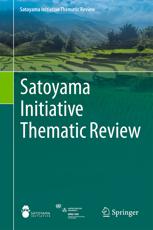The Satoyama Initiative: Integrating conservation and the sustainable use of biodiversity
Socio-ecological production landscapes and seascapes are areas where production activities help maintain biodiversity while sustainably supporting the livelihoods of local communities.
In this series of interviews, we talked to book authors and editors about how publishing open access has extended their impact and reach, something that is especially important to topics related to the SDGs.
Could you share a short introduction to your OA book series?

The Satoyama Initiative Thematic Review book series focuses on integrated landscape and seascape approaches for biodiversity conservation and sustainable development. Each book showcases a variety of local solutions and their contributions to the global agenda.
The series provides timely input for decision-making and action based on the lessons and evidence from on-the-ground management practices of “socio-ecological production landscapes and seascapes” (SEPLS). SEPLS are areas where production activities help maintain biodiversity and ecosystem services in various forms while sustainably supporting the livelihoods and well-being of local communities. It also feeds into the global efforts to strengthen evidence-based policymaking and sustainability implementation, including those under the Intergovernmental Science-Policy Platform on Biodiversity and Ecosystem Services (IPBES) and the Convention on Biological Diversity (CBD).
Which SDGs is the series related to?
Our book series is related to multiple SDGs, as SEPLS conceptualize landscapes and seascapes’ multifunctionality. The series contributes primarily to SDG 17 by strengthening the International Partnership for the Satoyama Initiative (IPSI), to realize societies in harmony with nature. IPSI’s case studies, compiled in the series, also feature a wide range of topics related to sustainable development and include major contributions to SDGs 15 (Life on Land) and 14 (Life below Water), and supplementing many others, such as SDGs 1, 2, 3, 4, 5, 6, 11, 12, and 13.
Why did you choose to make your book available on an open access basis?
We would like to ensure that our books are available for everyone interested in them without having any resource limitations. With open access, we hope to see an uptake of our policy recommendations and have more impacts on a science-policy-practice interface.
How was the open access fee (book processing charge) funded?
This book series is a flagship project of the International Partnership for the Satoyama Initiative (IPSI). The Ministry of the Environment, Japan has been providing funds and other support for IPSI activities and its secretariat, which is hosted by the United Nations University Institute for the Advanced Study of Sustainability (UNU-IAS), including the open access fee and other production costs for this series.
How were you hoping that open access would help with achieving your goals?
With open access, we can reach a broader audience. We can better inform policies and practices to facilitate action towards more sustainable futures.
Did you, your co-authors, editors promote the book yourselves? In what way?
We proactively engage in outreach activities whenever a new book in the series is published. For instance, we organize side events at the margin of relevant international processes, present posters at international conferences, speak at academic symposiums, and feature each volume in our IPSI newsletter and the university’s social media. Also, the books are used as course material for the post-graduate degree programmes at UNU-IAS.
Would you publish open access again?
Yes, absolutely.
Take a closer look at the book series Satoyama Initiative Thematic Review. We also invite you to visit our SDG OA Book campaign page, as well as our hub for SDG 17 ‘Partnerships for the Goals’.
Tsunao Watanabe is the Series Editor of the new open access book series Satoyama Initiative Thematic Review. He is Director of the Secretariat of the International Partnership for the Satoyama Initiative (IPSI), which is hosted by the United Nations University Institute for the Advanced Study of Sustainability (UNU-IAS). He also serves as Programme Head of Biodiversity and Society (BDS) programme as well as Director of the Operating Unit Ishikawa/Kanazawa (OUIK) at UNU-IAS. Prior to joining UNU-IAS, he was the Director General of the Nature Conservation Bureau of the Ministry of the Environment, Japan (MOEJ). During his long and extensive career at MOEJ, he was involved in biodiversity related policy development both domestically and internationally including the Satoyama Initiative and Intergovernmental Science-Policy Platform on Biodiversity and Ecosystem Services (IPBES). In 2010, he played a pivotal role in the success of the 10th meeting of the Conference of the Parties to the Convention on Biological Diversity (CBD COP10). Since 2012, he has supervised various activities at UNU-IAS.


